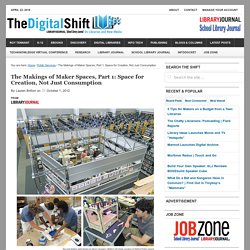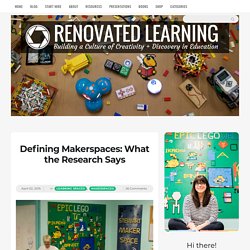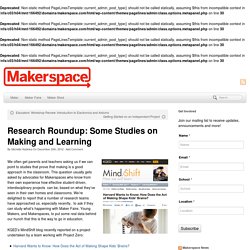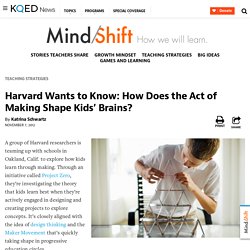

The Makings of Maker Spaces, Part 1: Space for Creation, Not Just Consumption. Maker spaces in libraries are the latest step in the evolving debate over what public libraries’ core mission is or should be.

From collecting in an era of scarce resources to curation in an era of overabundant ones, some libraries are moving to incorporate cocreation: providing the tools to help patrons produce their own works of art or information and sometimes also collecting the results to share with other members of the community. Maker spaces promote learning through play; have the potential to demystify science, math, technology, and engineering; and encourage women and underrepresented minorities to seek careers in those fields. They also tie in to the growing trend of indie artists in every medium—including books—who are bypassing traditional gatekeepers, taking advantage of new tools to produce professionally polished products, and going direct to the web to seek an audience.
Libraries around the United States offer tools for patrons to learn by doingBy Lauren Britton R. Fostering Creativity With Makerspaces. I've always found a sense of peace in the creative process.

It's a time when I feel like I don't have to stick with the rules in place for all the different parts of my life. That freedom helps me come up with some of my most creative ideas and exciting projects. This has been true my entire life. When I entered the classroom, I wanted to give my students as many chances as possible to be creative. Over the years, I've seen amazing projects from students who dared to take creative chances. I always come up with some big projects for my own students, but what about the rest of the building? School Librarians Push for More 'Maker Spaces' Manufacturing Makerspaces. Kids gather to make Lego robots; teens create digital music, movies, and games with computers and mixers; and students engineer new projects while adults create prototypes for small business products with laser cutters and 3D printers.

Many libraries across the US have developed makerspaces—places to create, build, and craft—and they are experiencing increased visits and demand as a result. For public libraries, they are places to promote community engagement. For academic libraries, they are places where students and faculty feel welcome to do classwork and research. Fundamentally, makerspaces are a technological leap past library knitting and quilting circles, where patrons and experts have often come together to learn new techniques and train others in a skill. The new tools are a lot flashier, and certainly more expensive than a needle and thread.
The ALA 2012 Virtual Conference featured two well-attended makerspace sessions. Three Makerspace Models That Work By Travis Good 1. 2. 3. The case for "maker spaces" in schools. Why school libraries should have STREAM Makerspaces. The Stewart Library Makerspace. School Libraries and Makerspaces: Can They Coexist? More and more schools are coming to value maker education and exploring ways to create makerspaces in their schools. Many schools are discussing how they might utilize their library to facilitate this. As my school has increased our commitment to constructionist learning and maker education over the last few years, we have done so in close collaboration with our school library. In exploring the relationship between the school library and school makerspace, it's not difficult to see why conversations about the growth of makerspaces are often tied to the conversation about the future of libraries.
Defining Makerspaces: What the Research Says. Recently, I had the unfortunate experience of dealing with criticism.

I was told (not to my face) by a visitor to our school that our library makerspace is not a “real makerspace”. This same person stated that our woodshop is a “real makerspace” because it has power tools. She suggested that I “do some research” on what makerspaces actually are. Feeling personally insulted aside, what bothers me most about this statement is the concept that some makerspaces are more valid than others and that a makerspace is solely defined by the tools it contains. I do agree that our woodshop is a makerspace, even though we don’t call it that. But is my space any less of a makerspace simply because it doesn’t have power tools? Defining Makerspaces All of this got me thinking about how we define “makerspace”. For the record, here’s my own definition of a school Makerspace: A #makerspace is a place where kids gather to create, invent, tinker, explore & discover. Research Roundup: Some Studies on Making and Learning.
Deprecated: Non-static method PageLinesTemplate::current_admin_post_type() should not be called statically, assuming $this from incompatible context in /nfs/c03/h04/mnt/166492/domains/makerspace.com/html/wp-content/themes/pagelines/admin/class.options.metapanel.php on line 30.

Harvard Wants to Know: How Does the Act of Making Shape Kids’ Brains? A group of Harvard researchers is teaming up with schools in Oakland, Calif. to explore how kids learn through making.

Through an initiative called Project Zero, they’re investigating the theory that kids learn best when they’re actively engaged in designing and creating projects to explore concepts. It’s closely aligned with the idea of design thinking and the Maker Movement that’s quickly taking shape in progressive education circles. Though it’s still in very early stages — just launched at the beginning of this school year — researchers and educators at the school want to know how kids learn by tinkering – fooling around with something until one understands how it works.
They want to know what happens cognitively – how this learning process helps form habits of mind, builds character and how it affects the individual. Harvard will give teachers specific activities to incorporate into the lessons they already plan to teach. Katrina Schwartz.